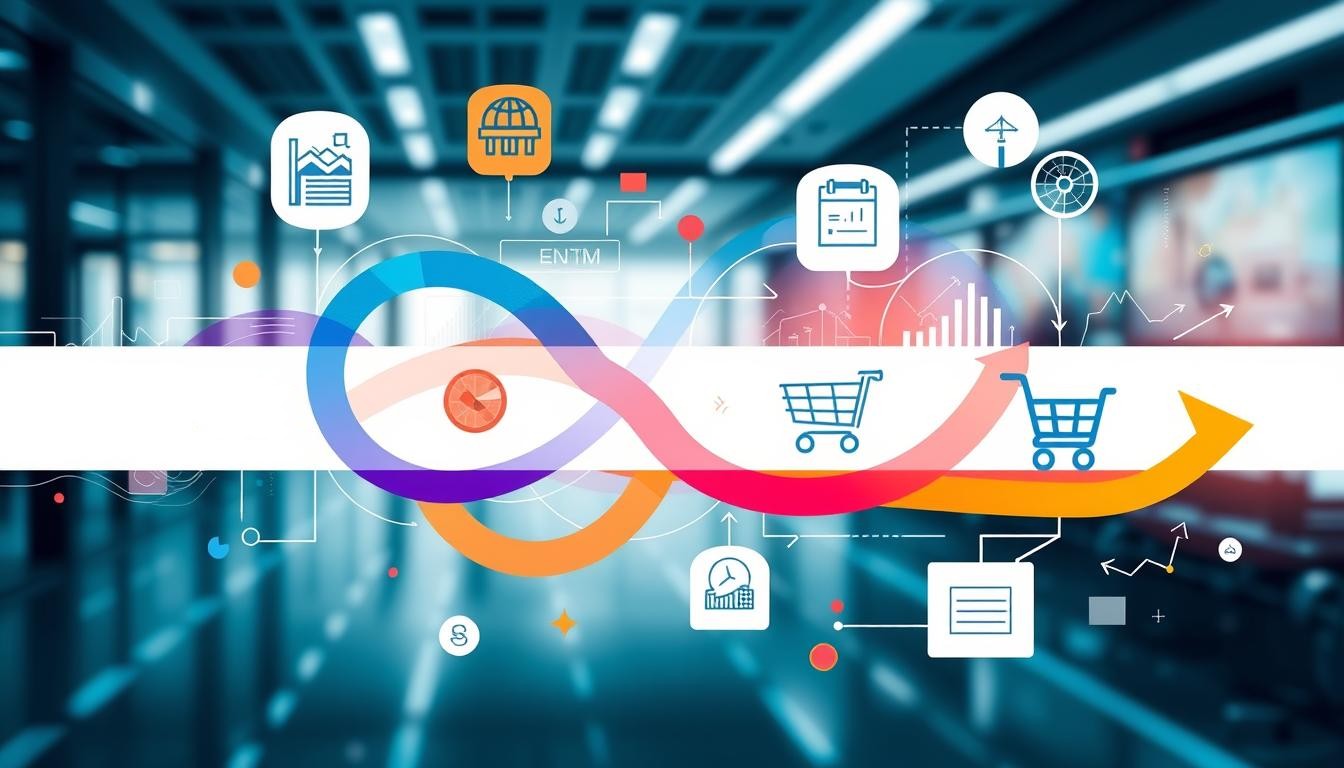Creating a smooth and enjoyable customer flow is essential for any business aiming to thrive. Every step of the customer journey should be seamless and engaging. This not only enhances satisfaction but also drives revenue growth and fosters loyalty.
Research supports this: Businesses that excel at understanding and improving customer journeys can see up to 30% higher satisfaction. They can also earn up to 20% more revenue, making it a compelling reason to prioritize this aspect of your operation.
But, understanding is only half the battle; action is key. Strategic store layouts boost sales by 15%, while clear queue lines delight 96% of customers. Mobile queue systems, which cut wait times by 20%, further demonstrate how thoughtful adjustments can create a stress-free and enjoyable shopping experience.
Customer flow encompasses the entire journey, from the moment shoppers enter your business to the time they leave. By analyzing touchpoints and optimizing each step, you can identify bottlenecks, reduce confusion, and increase efficiency. Studies highlight that effective customer flow management increases satisfaction by 10%. It also enables businesses to serve 15% more customers during peak times, leading to significant revenue gains.
Ultimately, good customer flow isn’t just about making sales — it’s about making each visit a memorable, hassle-free experience. By focusing on user experience optimization, you’ll position your business for long-term success.
Ready to transform your customer flow? Let’s dive into actionable strategies that work.
1. Analyzing Current Customer Flow
Understanding customer flow is key to improving business performance. Tools like Google Analytics track metrics such as conversion rates and sales. It helps identify pain points in the customer journey for targeted improvements.
Touchpoint mapping visualizes user actions across various interactions, from registration to product ordering. This approach reveals where users exit your website and when to offer assistance via chat.
Engagement metrics like engagement rates, NPS scores, and customer lifetime value are essential for evaluating customer flow. Focusing on these indicators helps optimize web content, simplify checkout processes, and build trust.
Advanced tools like Userpilot and Mixpanel provide detailed analytics that track customer journeys. They also identify the “happy path” — the ideal interaction route for users.
User flow analysis is an ongoing process. Regular evaluation and data-driven optimizations are vital to continuously improving the customer experience.
2. Designing an Effective Customer Journey
Creating a smooth customer journey is crucial for boosting sales and keeping clients happy. A well-designed path can lead to a 15% increase in overall sales. Businesses need to map out every step a customer takes, from entering a store to making a purchase.
User journeys give a big-picture view of customer experiences across different channels. They show how people interact with a brand over time. Journey maps help visualize these experiences, making it easier to spot areas for improvement.
User flows, on the other hand, focus on specific interactions within a product or service. You can see these using wireflows or flow charts. By combining user journeys and flows, companies can develop effective customer retention strategies that address both macro and micro aspects of the customer experience.
Personalized interactions play a crucial role in keeping customers engaged. With 80% of shoppers valuing their experience as much as the products, it’s vital to create a journey that feels tailored to each individual. Quick problem-solving is another key factor, as customers are 2.4 times more likely to stay loyal when you resolve issues promptly.
By optimizing store layouts, using clear signage, and implementing efficient queuing systems, businesses can reduce friction points. This creates a seamless journey from start to finish. This approach not only improves customer satisfaction but also helps tackle challenges like the 70% cart abandonment rate seen in online shopping.

3. Enhance Customer Experience
Studies show that a small boost in customer satisfaction can lead to a big increase in revenue. For a company making $1 billion a year, this could mean an extra $823 million over three years.
Personalization is a big part of making customers happy. Most people want brands to really get to know them. By tailoring services to each customer, businesses can build stronger relationships and keep customers engaged.
In today’s world, being on all platforms is crucial. Over half of all web visits come from mobile devices, so businesses must offer a smooth experience everywhere. This way, customers get the same quality service no matter where they are.
Happy employees make for happy customers. Companies with engaged staff do much better financially. Training employees well and listening to their ideas can significantly impact how you treat customers.
Adding self-service options and using tech for updates can also help. By listening to what customers say, businesses can always get better. This leads to experiences that make customers want to come back.
4. Use Technology To Improve Flow
Digital queue systems can cut wait times by up to 35%, boosting customer happiness. They also smooth processes and help manage customer relationships well.
Virtual queuing and self-service kiosks are big improvements. They let customers shop without waiting, boosting sales. In stores, smart layouts and signs help customers find what they need easily.
Data analytics provide insights for better customer flow. They help businesses understand how people move and when they wait. This allows them to plan better and hire the right staff. Companies that use these insights grow 85% faster in sales.
In healthcare, tech helps manage patient flow well. Universities use feedback to keep improving services. These tech tools make things more efficient and enjoyable for customers everywhere.

5. Train Staff for Optimal Service
Effective customer service training helps improve your staff’s skills and build a team ready for any situation. This not only improves customer satisfaction but also boosts employee morale.
A good training program should cover communication, problem-solving, and conflict resolution. Role-playing exercises are great for practicing these skills. They let staff try out real-life scenarios in a safe space.
On-the-job training is essential for roles that deal directly with customers. It gives employees practical experience in managing customer flow. This method works well in retail and hospitality, where staff interact with customers often.
When staff feel empowered to make decisions, engagement increases. Train your team to handle customer needs quickly, without needing approval. This autonomy leads to faster solutions and happier customers.
Regular feedback sessions are key for ongoing improvement. They offer chances to discuss challenges, share successes, and refine service strategies. This keeps staff motivated and focused on your customer service goals. Understanding user flow can also improve your training, preparing staff to guide customers effectively.

6. Implement a Feedback Loop
Creating a feedback loop involves gathering, analyzing, and using customer input. Many use tools like Net Promoter Score (NPS) and Customer Satisfaction (CSAT) surveys to get feedback.
These methods help understand what customers need and make improvements. Customer feedback analysis is vital. It helps find areas for improvement and tracks satisfaction.
For example, brick-and-mortar stores use Google reviews, while software companies use special platforms. E-commerce sites often rely on customer product reviews.
It’s important to make changes based on feedback for continuous improvement. Companies that update based on customer input do better. In fact, 86% of consumers are willing to pay more for a better experience.
A good feedback loop has four steps:
- gathering feedback
- analyzing data
- making changes
- following up.
Automating parts of this process saves time and boosts efficiency to keep improving customer service and overall experience.
7. Measure Customer Flow Success
CSAT and NPS are important for measuring customer happiness and loyalty. High scores show your strategies are effective. The customer health score helps spot at-risk customers early.
Time to value shows how quickly customers get results. Faster results lead to more customers staying. The retention rate shows how many customers keep using your service over time.
User flow analysis helps understand how customers behave. It finds the best path to value and improves the user experience. Setting clear goals and using the right tools gives detailed insights into user behavior.
8. Reduce Friction Points
Friction points can stop customer experience optimization efforts. These obstacles include discovery, purchase, and post-purchase challenges. Businesses must focus on areas that affect customer satisfaction.
Website optimization is key to reducing friction. It’s about making websites load faster and checkout easier. Offering many payment options also helps. Clear content helps customers make better choices.
Good support systems boost customer loyalty, and quick issue resolution turns problems into positive interactions.
Post-purchase engagement is also vital. A smooth onboarding process answers questions and supports customers. This lowers churn rates and builds lasting customer relationships.
Identifying friction points improves customer experiences and keeps customers. Customer journey maps help spot issues. Qualitative research, like NPS surveys, shows what customers feel.
Reducing friction is an ongoing task. Always check your customer flow and improve based on feedback. This effort makes the customer journey smoother and more satisfying.
Continuous Improvement Strategies
Companies need to refine their processes and adapt to changing needs consistently. Continuous improvement is key to staying competitive, enhancing customer satisfaction, and driving long-term growth. The following strategies can help businesses streamline operations, reduce waste, and foster a culture of ongoing improvement.
- Agile Customer Service: Focus on adapting quickly to customer needs and making continuous improvements over time to enhance customer satisfaction.
- PDCA Cycle (Plan, Do, Check, Act): A systematic approach to continuous improvement, involving planning, implementing, checking results, and taking corrective actions to refine processes.
- Value Stream Mapping: A tool that visualizes the entire process from start to finish, helping identify areas for improvement and streamlining operations.
- Lean Improvement: A method developed by Toyota to eliminate waste, reduce costs, and improve overall efficiency in business processes.
- User Experience Improvement for Digital Businesses: For digital platforms, such as mobile apps, focus on identifying key features and refining them based on user feedback. This helps create a smooth and enjoyable user experience.
- Clear Communication and Constant Monitoring: Ensure effective communication across the team and consistently monitor progress to implement improvements successfully.
The Future of Customer Flow
The world of customer service is changing fast, thanks to new tech and what people want. Companies are using new ways to make things easier for customers. They focus on making user flow design better, so interactions are smooth everywhere.
Artificial Intelligence (AI) and machine learning are leading this change. They help make experiences personal by understanding what customers like. For example, Waitwhile’s platform has helped over 200 million people. Their new version, 3.0, will make booking faster and give better insights into how customers move.
Augmented reality is also changing things, especially when shopping in stores. It helps guide people around, making shopping better. Companies are also working on making experiences consistent and personal. They’re using WhatsApp Conversations and new mobile features to meet customers where they are.
Looking forward, we’ll see even more ways for different platforms to work together. Businesses that keep up with these changes will be ready for what customers want. They’ll stay ahead in the fast-changing world of customer service.
Smooth Sailing: Mastering Customer Flow With Mood Joy
To wrap it up, getting a handle on customer flow is a game-changer for any business. When you really understand how people move through your process, you can spot what’s working and what’s not.
By making things smoother and more intuitive, you’re not just making life easier for your customers — you’re building trust, loyalty, and better relationships. At the end of the day, it’s all about creating an experience that feels effortless and keeps them coming back.
Mastering customer flow is just the start of creating seamless, engaging experiences that truly resonate with users. If you’re ready to explore more strategies to elevate your UX/UI design, from optimizing navigation to crafting intuitive user journeys, head over to Mood Joy. Let’s dive deeper into the art of designing experiences that truly resonate with your users.



